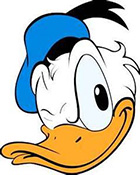volume 7 1937-1938
| série: | Tarzan Sunday Pages |
| dessinateur / scénariste: | Hogarth Burne |
| éditeur: | Flying Buttress EO 1994 |
| genre: | Aventure |
| classement: | biblio1 |
| date: | 1994 |
| format: | cartonné avec jaquette |
| état: | TBE |
| valeur: | 30 € |
| critère: | *** |
| remarques: | seventh volume edited by NBM/Flying Buttress (NBM being America's first publisher of graphic novels since 1976, located at New York with imprints such as Flying Buttress Classics Library, Amerotica, Eurotica and ComicsLit) under the supervision of Bill Blackbeard out of a sery of 18 volumes, all being accurate reproduction of the Sunday Pages in their full colour and in full size, each volume has about 52 pages, n.b. the sources of these Sunday pages are mainly from the Los Angeles Times and from the Milwaukee Journal edited by UFS (United Features Syndicate) volume 7 1937-1938 with dust jacket from 19.9.1937 (341) to 11.9.1938 (392) = 52 pages drawn by Burne Hogarth, based on the novel of Edgar Rice Burroughs Tarzan lands in the unusual reversed situation of having to defend white settlers against the wiles of an unscrupulous tribe led by the roguish Ishtak who falsely "sells" land to them with treacherous ulterior motives the volume includes following episodes (number of pages): - Tarzan in the City of Gold part three: 3 - Tarzan and the Boers part one: 34 - Tarzan and the Chinese part one: 15 1/ introduction by Bill Blackbeard "Tarzan à la mode de Hogarth" (1911-1996) - Hogarth with his graphic dynamics (at full creative style as per 5-5-1940) was one of the most original and inventive cartoonist, similarly to Foster, Hogarth avoided however the use of word ballons in the comic strips of Tarzan reducing dialogue of any kind to a bare minimum, but story colour and action were to such an intense degree that one had rarely to pause for reading much of anything revelling in bizarre alien architecture, monsters and other incredible jungle creatures - the first strip produced by Hogarth was "Ivy Hammanhaw" in 1929, then "pieces of eight" (about the pirate Blackbeard!) in 1934 at McNaught syndicate and when Foster quitted his job in 1937, Hogarth was selected out of many candidates - in 1944, Hogarth started his own creation "Drago" (a kind of Zorro story in Argentina) which however worked to his disadvantage; in 1945 Hogarth stopped drawing Tarzan and Ruben Moreira (Rubimor) stepped in Tarzan's strips as a third-rate comic artist, it was a disaster (however it might have been a planned disaster, in that case not to choose and commit oneself to a talented artist difficult to be replaced so that Rubimor would be more easily replaced) - 1947, after the failure of Drago, Hogarth restarted his work with Tarzan, but already in 1948 he realized a new own strip entitled "Miracle Jones" representing an old-style slapstick comic (slapstick = low comedy of the roughest kind); Hogarth stopped Tarzan definitively in 1950 in the 1990s, he returned to the field once again with the mini-series 'Morphos the Shapechanger' with Harry Hurwitz, published by Dark Horse Comics, however, Burne Hogarth completed only one issue, he passed away in Angoulême in 1996, after suffering from a heart attack 2/ the story city of gold part three: the jungle forces have finally smashed the modern army and this time Flint could not escape his fate; leaving accidently the realm of gold unnoticed, Tarzan meets in the jungle the cabin of his birth once more, then Tarzan rescues his foster ape-people from the black cannibals = the Mbonga's tribesmen who have captured Taug, poster-brother ape of Tarzan n.b. foster = parent, of the same family Tarzan succeeds in liberating Taug and taking as booty two of the cannibals who are to be sacrificed on the dum dum altar >> p. 349 but this time Tarzan does not share this brutal orgy, however he was too wise to attempt to impose his own code upon the brute instincts of the apes back among his brave Waziri's warriors, Tarzan receives the visit of the messenger of Ishtak, chief of a far south tribe who is asking for help against white invaders, meeting of Tarzan with Ishtak and with the Boers during which the treachery of Ishtak is revealed, battle on the veldt where the warriors of Ishtak are defeated >> p. 351 the trekkers called boers = true pioneers >> p. 354 the gravest error than Tarzan ever made (again!) to let Ishtak go away unscathed n.b. same page Ishtak wears same cloth as Tarzan. Jan van Boeren, chief of the Boers decides to remain in the land despite the danger of Ishtak's savage warriors but Annitje, his adoptive daughter is filled with terror and starts to flirt with Tarzan >> p. 361 there can be no love affaires with Tarzan >> p. 367 Ishtak the villain = a typical face drawn in Hogarth's style new onslaught of Ishtak's warriors on van Boeren's home, the savage men are repelled again but this time they have received modern rifles from the white traitor Henrik Smit and are becoming a greater menace, therefore Tarzan and the Boers build a fortified town, Annitje's hatred towards Tarzan by rallying Henrik the traitor, but Tarzan and his friend in a final battle defeat Ishtak who finds also his fate, peace is restored with Ishtak's successor >> p. 368 Annitje, the foster-child on his way home, Tarzan discovers a mysterious lost civilization guarded by two walls with inbetween a barrier of beasts being mammoth lions! >> p. 378 the Chinese wall in the jungle of Africa >> p. 380 the loin-cloth of Tarzan has changed: in a looser way and of different colour and reference to the Chinese wall as an intruder Tarzan is captured and presented in front of the emperor Sat Sun Tai and as a stranger Tarzan must die by force of the law, but Tarzan is saved by princess Luling, daughter of Sat Sun Tai who wants his father to adopt Tarzan as her foster-brother, so that Tarzan should no longer be a stranger >> p. 383 the pretty princess Luling later on, the city is attacked by some bandits called "the horsemen of doom", the Chinese are afraid and do not wish to fight but >> p. 386 Tarzan inspires strength and courage to the civilized men, however despite their efforts, they are taken prisoners by the bandits >> p. 387 Tarzan is sentenced to death by Chang-Loon, chief of the bandits, but Tarzan is saved by a pack of lions charging the bandits who despatch themselves very quickly, however a new menace is arising: Hiyedo, the barbarian war-lord and his black warriors Aiyus >> p. 390 even to safe his life, Tarzan never lies >> p. 391 the birth of the explosive powder >> p. 392 Tarzan is nominated chief of the Chinese army to fight against Hiyedo's savage warriors >> a very good volume with the excellent artscraft of Hogarth, beautifully coloured, any resemblance with Foster's style is now gone and in this first episode with the Boers and the Chinese, Hogarth's style becomes more personified (especially pages 346-355 and 378-390 whose colour are well painted n.b. Hogarth starts now to make use of strips of different size, in this volume he has presented some strips on full page width and also bringing more details on the background ; to notice: the beautiful sensuous face of the Chinese princess being part of a superb volume cover also to notice: the cover shown now a blue colour tendency instead of the previous green one P.S. Tarzan and the Boers part one is presented with the title "Tarzan trahi" in the edition Hachette Enclosures - front and back cover of the volume - extract from Morphos the Shapechanger - various pages out of volume 7 |
| couvertures: | 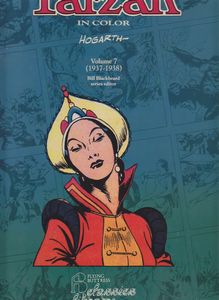 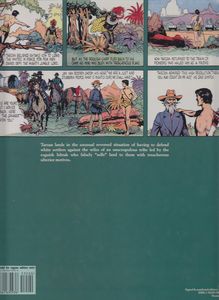 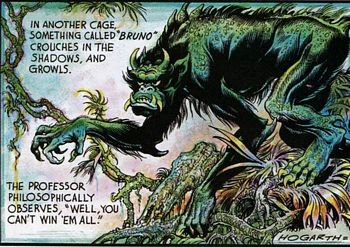 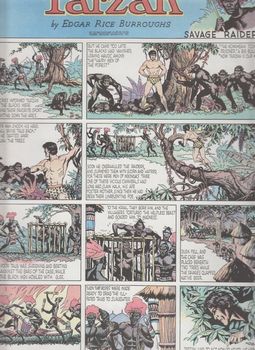 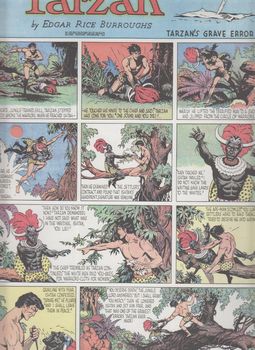 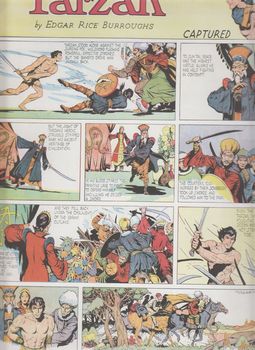 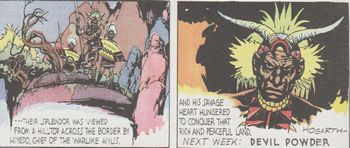 |
Copyright 2008 - 2025 G. Rudolf
